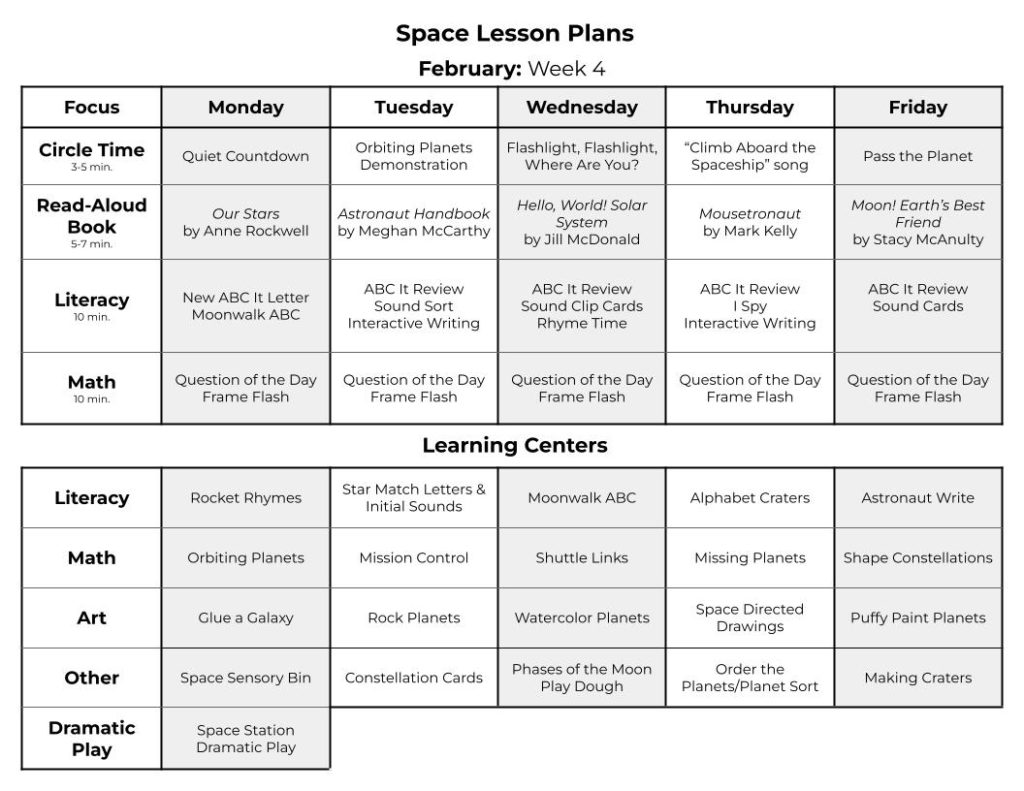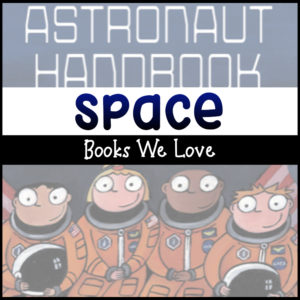The world revolves around toddlers. At least, they like to think so. They grow and change into a “big girl” or a “big boy” and then they really think they are the best thing since sliced bread. In reality, I think everyone (toddlers and adults alike) can all get a little too hyper-focused on themselves and their lives. But there are moments that show us that we are miniscule in comparison to the universe. This is why I love star-gazing. It reminds me that there is so much more than just us. We can’t begin to show this to our children without first teaching them about space. And what better way to teach them about space than to have them pretend to be astronauts. This space dramatic play sent the kids out of this world with so many opportunities to learn about space.
This post contains Amazon affiliate links, which means I earn a small commission from qualifying purchases at no extra cost to you by linking to Amazon.com. See the full disclosure here.
Space Lesson plans

Space Station Dramatic Play
Set-Up
The moment that space shuttle backdrop went up, it was literally like my kiddos were transported to a new world – out of this world, you could say. Their eyes lit up and the wheels started turning in their little brains as to what adventures this space set-up could take them on. Instantly, they sat down in the space shuttle, which I created with a small table, two chairs, and a cube shelf to create a long space ship area.
The prop that really helped this center blast off was the backdrop, which was leftover from a Mandalorian birthday party. Somehow my husband brainwashed my 6-year-old girly girl that this would be awesome. Oh, the power of Daddy.
The cube shelf that helped create our space shuttle was also where I stored all of our supplies. We kept the Mission Control checklist there, which was such a huge help in guiding prolonged dramatic play. This was where the balance scale and moon rulers for the Moon Rock Observations were kept, as well as the Astronaut Food station.
Skills:
- represents fantasy, real-life, imagination, and literature through dramatic play
Launch checklist
Astronaut Dramatic Play
The first step to reaching outer space is to prepare to launch. Not only does this checklist guide dramatic play, but it helps toddlers learn some of the important steps that astronauts go through before launch.
They can complete a safety inspection, check the fuel levels, check the weather, and draw a flight plan. There are several different flight plans to trace, working on those ever-important pre-writing skills. I just looped all of the flight plans together using a binder ring to keep everything nice and organized.
Then, buckle up, test your communication, and lock the doors. We used whisper phones as our communication source, but you could also use a pair of headphones as an engaging prop to draw in the little ones.
After that, we used our Mission Control board to start our engines and blast off. Read more about that below.
Skills:
-
participates in teacher-guided and/or spontaneous dramatic play activities such as acting out a story
Mission Control
Math Through Play
I am constantly looking for ways to incorporate learning through play. Astronauts have to learn a ton of math and apply it constantly throughout their missions, so tying math into this space station dramatic play was the perfect opportunity! Plus, I got the genius giggles when I came up with this one, which can only mean it’s really good.
First, we flipped over a mission number card that included tally marks to let us know which mission we were on. Very important information, indeed. Then, we spun the arrow on the dice dial to match the mission number. Next, we added magnets to show the number as ten frame buttons. Oh, man, the excitement is building as we prepare to launch. Flip the switches to start the system, start the engine, increase power levels, and hit the thrusters. Finally, count backward from the mission number: 3-2-1 Blastoff!
This Mission Control board is full of so many ways to learn through play. It can be used in your space dramatic play center as well as in math. Mission accomplished.
Skills:
-
- count to answer "how many?" questions about as many as 10 things arranged in a line, a rectangular array, or a circle
- count to answer "how many?" questions about as many as 10 things arranged in a line, a rectangular array, or a circle
Mission Report
Space Station Dramatic Play
As if there weren’t already tons of things to do before the space shuttle launches, there are so many missions to complete while in outer space. This Mission Report will guide preschoolers and toddlers to pretend to be astronauts with a list of missions to accomplish while in space, including:
- make observations
- collect moon rocks
- observe moon rocks
- drive lunar rover
- build a satellite
- do a space walk
- exercise
- eat astronaut food
- create flight plan
Read more about these activities below.
Skills:
- assumes the role of something or someone else and attempts to speak in the appropriate manner and tone
Moon Observations
Learning Vocabulary Through Play
While on the moon, the children can collect data about what they see in the solar system. I’ve included real photographs of planets, stars, constellations, a satellite, and more for them to view through their telescope. Just print, roll, and tape it together. My daughters constantly collect cardboard tubes to use as telescopes, so I figured why not learn some space vocabulary while we’re at it?
Then, they can mark which object they spotted on the recording sheet. There’s even some sight word sentences on there to encourage some beginning reading.
Skills:
- makes simple observations of the characteristics and movements of sun, moon, stars, and clouds
- displays emergent reading behaviors with purpose and understanding
Moon Rock Observations
Incorporating More Math
This next set-up is sure to inspire some laugh-worthy moonwalks. I set up our moon (a picnic blanket with waterproof foil on one side) with grid lines. Just use masking tape on the carpet if you don’t have a crazy space blanket. Then, we set out our lettered astronauts to make this a letter identification activity as well. Finally, crumple up some aluminum foil to make some moon rocks. We would have just used real rocks, but they are really heavy to weigh on the balance scale with teddy bear counters.
Back on the cube shelf, I set out the balance scale, a magnifying glass, moon rulers, and the Moon Rock Observations recording sheet. Perfect for our little scientists aboard the space shuttle.
This activity offers so many different ways to learn through play. First, the children use the moon rulers to measure the length of the moon rock they collected for measurement, number identification, and number formation. Then, they weigh the moon rock on the balance scale for measurement, counting, and more number formation. Last, they draw a picture of the rock next to the letter they found it by for letter identification.
Skills:
- recognize and name some upper/lowercase letters of the alphabet
- when counting objects, say the number names in the standard order, pairing each object with one and only one number name
- identify measurable attributes of objects, such as length, and weight
Astronaut Food
Space Station Dramatic Play
Not gonna lie: this, of all of the cool activities aboard this space shuttle, was the favorite. At first, I thought it was the pompoms. But then, I realized it was the empty soap bottle that my kiddos were obsessed with. Sometimes, it’s the little props that really make dramatic play exciting. So, if you have an empty soap bottle, don’t throw it away just yet!
After reading about how astronauts eat dehydrated food and have to keep it on a tray with covers so it doesn’t float away, we made an astronaut tray of our own. Just a small cupcake tin on top of a cookie sheet (both found at Dollar Tree). Then, I placed all of our dehydrated food in plastic bags with these awesome labels, complete with a bar code and a coded identification number (I do love me some puzzles).
The first time we set up a space station, I actually used oats and dried peas in bags, but I realized that the kids really enjoyed putting the food in the cupcake tin, so I changed all the food to pompoms and felt – both easy to clean up!
Skills:
- uses basic props, and costume pieces to establish time, setting, and character
build a Satellite
STEM Challenge
This next challenge is to encourage all of your makers and builders to join in the dramatic play center – as if the children won’t be gravitating over there anyway (see what I did there). My daughter is definitely one of these makers. Save all of the recycling and stock up on tape, people, because making her own creations is what she is all about. I mean, she made a crib out of a Nerd box the other day.
Save these recyclables for your satellite station:
- applesauce cups
- cardboard pieces (cut into rectangles)
- coffee cans or oat tins
- plastic cups
Then, just wrap up your cardboard pieces with aluminum foil just like a present and add in some foam shape stickers. Some peeps may use a sticker or two (see picture at the top) and some may be determined to use all the stickers (see picture at the bottom).
Skills:
- uses materials to build and create "pieces" that represent another item
- uses pincher grip (index finger and thumb)
Astronaut Equipment
Dress-Up Area
I don’t know about you, but my girls would wear dress-up on a daily basis (if only I could keep up with the laundry). The outfits magically transfigure them into a princess, Minnie Mouse, or Batgirl. Whenever possible, adding dress-up to the dramatic play center enhances the experience.
In this case, an astronaut costume is such a fun prop to add to this space station. It can even help teach about different astronaut equipment. Just use the diagram to help. This diagram also comes with a blank version for students to fill in to use in the dramatic play center or even the writing center.
Skills:
- uses more complex words in conversation
- uses basic props, and costume pieces to establish time, setting, and character
You might also like...
MORE Space Activities
While your preschoolers may still believe they are the center of the universe, I hope this space dramatic play set gets them thinking about how infinite outer space is and offers learning through playful experiences. Maybe one day, they will realize there’s more than just our house, our country, and our planet. There’s a whole universe out there to explore. Enjoy and go and make your teaching ridiculously amazing!



















